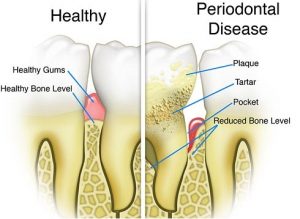
Gum disease is one of the most common dental diseases. According to the Centers for Disease Control and Prevention (CDC), over 47% of adults over the age of 30 have some form of gum disease. It is more common in men than women, in people living at or below the poverty level, in those with less than a high school education, and smokers.
In most cases, gum diseases are reversible and can be cured. In this article, we discuss the stages of gum disease, the difference in gingivitis and periodontitis, and how to prevent and maintain healthy gums for a lifetime.
Stages of Gum Disease
There are several stages of gum disease ranging from easily reversible gingivitis up to advance stage periodontal disease that affects the jawbones.
Symptoms of early gum disease stages, such as gingivitis, include gums that bleed easily and that appear red and slightly swollen. This is a sign of gum infection. Bad breath can also indicate gingivitis. Gums should not bleed when you brush your teeth any more than hands should bleed when you wash them. Bleeding gums are not normal.
In later stages of gum disease, the infection spreads from the gums into the bone. This is called “periodontal disease” or “periodontitis” because it affects not just the gums but also the bone surrounding the teeth. The teeth may become loose in their sockets. Not only is the breath bad, but there is sometimes a constant, sour taste coming from the teeth.
How to Identify Gingivitis
If you see pink in your saliva when you brush your teeth or notice blood on your toothbrush, this is an early sign of gingivitis. Make an appointment to see your dentist or dental hygienist as soon as possible to rule out anything more serious.
If it has been more than six months since you last had your teeth professionally cleaned, that procedure will usually be the first service needed to address your gingivitis.
Plaque Buildup and Gingivitis
Over time, bacteria, food debris, and a sticky film called “plaque” build up around the edges of your gums and in between your teeth. This build-up eventually hardens and acts like tiny splinters under your gums, keeping them irritated and sore. Removing those deposits will usually relieve the symptoms of gingivitis and get you back on the road to good oral health.
Sometimes, the buildup on your teeth has gotten so deep that it requires more than just a simple cleaning to remove. In these cases, the dentist or dental hygienist may need to numb your gums to get their instruments beneath them to remove the bacterial build-up. You may need to make several trips to complete this type of gingivitis treatment because the dentist or hygienist can only numb a portion of your mouth at one visit.
Diagnosing Gingitivits

Diagnosing gingivitis and the more serious periodontitis requires the expertise of a dentist or dental hygienist. They examine the teeth and gums using special measuring devices that show how deep the deposits extend beneath the gums and may need x-rays to see if the jawbone has been affected.
Periodontal Charting can also be performed to examine the health of the teeth and gums. This technique is the best way to determine if a patient is periodontally healthy or suffering from periodontal disease. During periodontal charting, the “pocket,” which is the area between the gums and teeth, will be examined using a periodontal probe. A periodontal probe measures the depth of the pockets in millimeters. Gums measuring anywhere between 2-3 mm are considered healthy, anything over 5 mm means the bone supporting your teeth is beginning to deteriorate. Bleeding is also an indicator of gingivitis and gum disease.
After gathering the needed information and making a diagnosis, the dentist will make a treatment plan unique to your situation. They will explain each step in the plan, what is involved, how many trips it will take, and the cost. You might want to check with your insurance company to find out if your plan covers some or all the costs.
Once you have a diagnosis and a gingivitis treatment plan in place, the next step is to schedule your appointments. It may take anywhere from one trip for mild cases up to five or six for advanced cases. If the periodontal disease is far advanced past the stage where gingivitis treatment is not enough, the dentist may need to perform gum surgery. But for gingivitis and early-stage periodontal disease, treatments usually do not require surgery.
Prevention & Maintenance
After completing all stages of the gingivitis treatment plan, your journey back to good oral health is not over. Maintaining healthy gums and bone is a lifetime commitment that you should take seriously.
After your battle with gingivitis, maintaining excellent oral health practices is necessary. Commit to daily brushing with a soft toothbrush, flossing to remove bacteria and food debris from between your teeth, and having regular cleanings as advised by your dentist or hygienist.
Healthy gums should be pink and tough, much like a callus on your hand. They should never bleed. Occasionally, a popcorn hull, tomato seed, or a similar irritant might get stuck under the gums and cause temporary soreness. But you should report any soreness or bleeding with no identifiable cause that lasts more than a day or two to your dentist.
Preventing gum disease from returning is much easier than having it treated. Not only is daily brushing and flossing necessary but eating a healthy diet helps keep your gums and bones in top condition. Avoid sugary foods and drinks, including diet sodas that are high in acids.
Maintaining Dental Hygiene with Regular Cleanings
Going to see your dentist or dental hygienist regularly allows them to remove buildup under your gums and between your teeth that you are not able to reach with a brush and floss. Much like taking your car for regular oil changes and tire rotations, seeing your dentist on a regular schedule ensures that your oral health will not deteriorate again. It is recommended to visit your dentist for a cleaning every six months.
Gum diseases like gingivitis and periodontitis are preventable. Removing bacteria, plaque, and food debris daily along with having regular checkups and professional cleanings helps to ensure that your teeth will last for many years.
Everyone wants a beautiful healthy smile! Keeping your gums strong and pink requires a team effort—you carry the ball of daily cleaning and your dentist carries the ball for early diagnosis and treatment. Together you can be confident that your gums will stay healthy for a lifetime. To ensure your smile is healthy, schedule an appointment with us at Advanced Periodontics & Implant Dentistry by calling (877) 316-4330.
